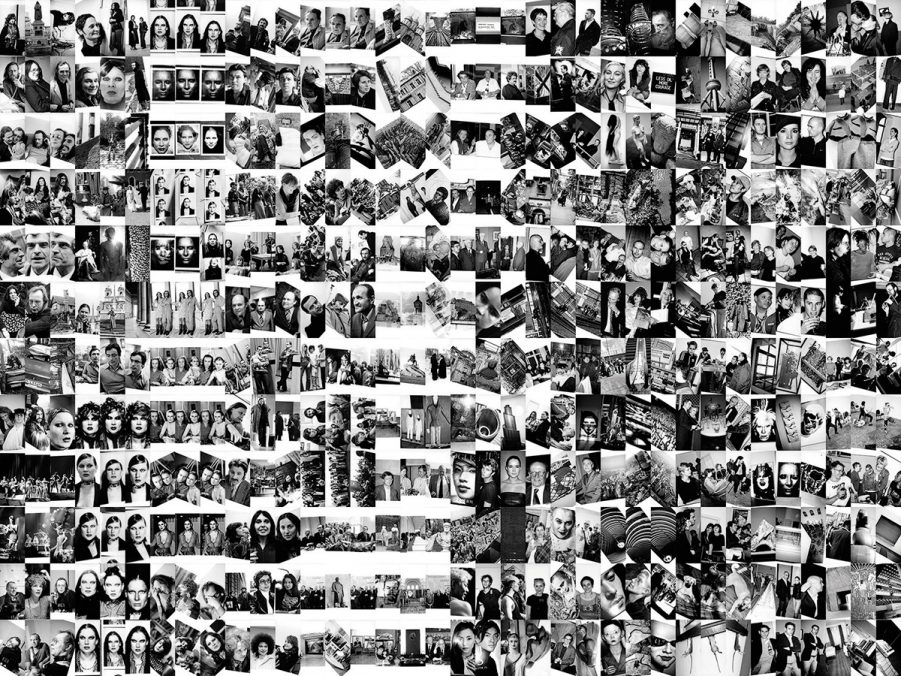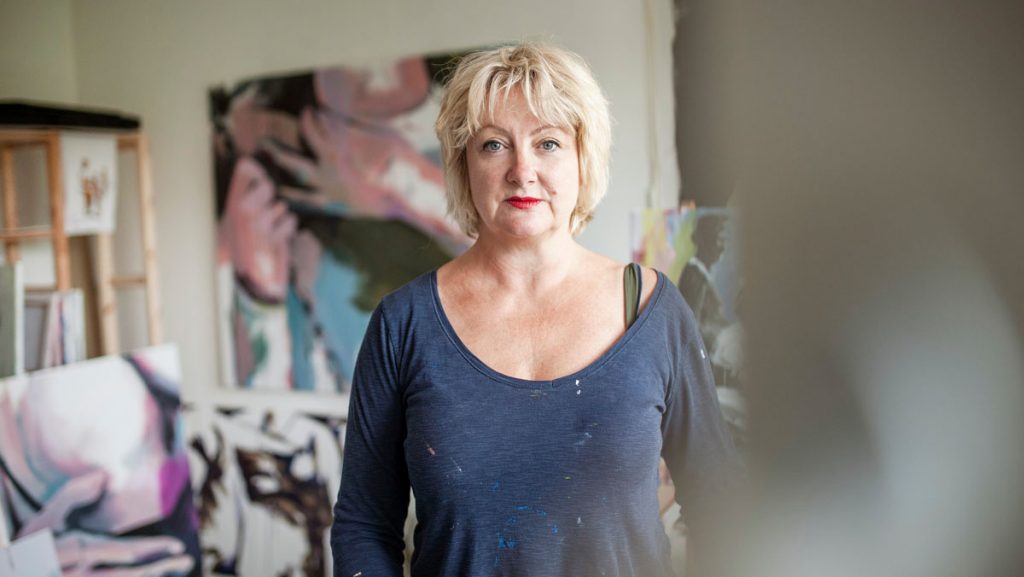
Curated by Udo Kittelmann in cooperation with Katharina Sieverding, Watching the Sun at Midnight pays homage to Sieverding’s persistent treatment of contemporary German and global matters, one that has ensured the ongoing relevance of her work over the past 60 years. In conjunction with the exhibition in Baden-Baden, Salon Berlin presents Headlines, a thematically focused selection of large-scale photographs referring to the darkest chapter in Germany’s history, the National Socialist era, in the Former Jewish Girls’ School in Auguststrasse in Berlin.
Organized in collaboration with Deichtorhallen Hamburg, Watching the Sun at Midnight is an extensive solo presentation of Czech-born German artist Katharina Sieverding’s (b. 1944, Prague) work, covering all phases of her oeuvre from her videos of the late 1960s to her oversized self-portrait series of the 1970s and up to her contemporary productions, with new works including Gefechtspause (“Ceasefire”), which addresses the lockdown during the COVID-19 crisis. This exhibition is the latest in a series of monographic exhibitions of photography-based positions at the Museum Frieder Burda, including Gregory Crewdson, Andreas Gursky, Rodney Graham, and JR, all of which investigated the staging opportunities and great breadth of technology as opposed to painting.

A student of German artist Joseph Beuys, Sieverding has continuously focused her artistic energy on political issues. Considered a pioneer of photography internationally, testing the boundaries of the medium’s manifold technical possibilities, she is known for her unconventional visual strategies and media-led creative practice. She has revitalized the artistic potential of photography, introducing the super-sized format as a key element of her exhibitions, at a time when the practice was seldom utilized. In her serial photographic works, she gives expression to reflections about identity, the current social, political, and cultural climate, gender discourses, and the necessary emancipation of the female artist. Mirroring her themes and subjective perception of current events, her works convey an image of the time.
From the microscopic to the macroscopic, the references in her oeuvre are complex. Her father’s clinically dissecting view sharpened her own focus and opened it to the technical opportunities presented by her chosen medium. From her origins in theater, Sieverding understood how images on a wall can define an entire room, with the same immediate and all-consuming effect of a stage backdrop or a big screen in a cinema – which in turn unlock the imagination for an introspective look at fantasy worlds. Her pictures, often in black- and-white with a bright red signal color and accompanied by striking slogans, reflect media-based and commercial manipulation strategies, questioning them at the same time: it is no coincidence that the artist has repeatedly and consciously escaped the museum setting and sought direct contact with the broader public in common urban spaces. Her earlier, highly self-reflective role in the Düsseldorf art scene, which came across mainly as a men’s club, raised her awareness of the question of one’s own individuality and identity, gender, history and its conditions – and the fluid borders and process-like transformations between these categories.
I don’t make propaganda art and I don’t want to be seen as somebody who stands for anything in particular. All these designations merely pin me down. I want to adopt an independent position and express my thoughts through my works. – Katharina Sieverding

In addition to the presentation at Museum Frieder Burda in Baden-Baden, the concomitant exhibition Headlines will be on view from September 3 – 26, 2021, at the institution’s Berlin-based exhibition space, Salon Berlin, located in the notable Former Jewish Girls’ School on the city’s historical Auguststrasse. The thematic selection brings together large-format photographic works by the artist that turn to the darkest part of German history: that of National Socialism. Through these photographs, which build on documents from the concentration camps at Dachau and Sachsenhausen, as well as records held at the Holocaust Memorial in Berlin, Sieverding points to the widely diverse manifestations and expressions of anti-Semitism and exclusion, racism, and violence, outlining the latter’s timelessness and societies’ inability to surmount them as they recur throughout history. On the occasion of her exhibition in 2019 at the Dachau Palace, the artist herself stated, “[t]his moment in time has vehemently touched me, especially as I observe the current evolution of Germany.” In parallel, moving from the shared history to her personal biography, the artist also presents monumental self- portraits from the late 1960s and the work TESTCUTS, a reflection on Katharina Sieverding’s own life: events in the art world from 1966 to the present are shown together to form a large-scale 20 meter photo collage. Considered one of the leading art museums in Germany and internationally, Museum Frieder Burda is home to its founder Frieder Burda’s extensive and growing collection of Classical Modernism and Contemporary Art, encompassing over 1,000 paintings, sculptures, objects, photographs, and works on paper. In addition to its collection, the museum has mounted major solo exhibitions, presenting works of Gerhard Richter, Sigmar Polke, Katharina Grosse, William N. Copley, Andreas Gursky, and James Turrell. Inaugurated in 2004, the museum’s five-storey building nestled in Baden-Baden’s majestic Lichtentaler Park, designed by iconic New York architect Richard Meier, caught the world’s attention for the luminosity of the design, inducing visitors to experience the art and the space in an equally awe-inspiring manner – and owing it to be referred by many as the “Jewel in the Park” in the newly recognized UNESCO World Heritage site of Baden-Baden.

About Katharina Sieverding: Born in Prague, Katharina Sieverding studied at the Hamburg Academy of Fine Arts and at the Düsseldorf Academy of Art. She was involved in several theater productions as a stage designer, including the Deutsches Schauspielhaus Hamburg, the Burgtheater Vienna, the Düsseldorf Schauspielhaus and the Deutsche Oper Berlin. In 1967 Sieverding joined the class of Joseph Beuys at the Kunstakademie Düsseldorf. She traveled to and gave lectures in Canada, the People’s Republic of China and the Soviet Union. From 1990 to 1992, she was a visiting professor at the Hamburg University of Fine Arts and subsequently held a professorship for Visual Culture Studies at the Berlin University of the Arts. Other guest professorships included the Center for Contemporary Art Kitakyushu in Japan, the International Summer Academy in Salzburg and the China Academy of Art in Hangzhou. Her work has been shown in 850 group and 150 solo exhibitions and is represented in numerous renowned collections, including the Museum of Modern Art, New York, the San Francisco Museum of Modern Art, the Stedelijk Museum, Amsterdam, the Nationalgalerie, Berlin, the Museum Folkwang, Essen, and the Kunstsammlung NRW. Katharina Sieverding has participated in the documenta in Kassel several times and in the Venice Biennale. She has received numerous prestigious awards and scholarships. Katharina Sieverding lives and works in Düsseldorf.
About Udo Kittelmann: Udo Kittelmann (Düsseldorf, Germany, 1958) is the artistic director of the Museum Frieder Burda, Baden- Baden. Long-time director of the Nationalgalerie in Berlin (2008-2020), he has also acted as director of the Kölnischer Kunstverein (1994—2001) and of the Museum für Moderne Kunst, Frankfurt (MMK) (2002—2008). A world-renowned curator known for his investigations of curatorial practices and institutions’ relationships with art, Kittelmann has based his curatorial approach on close collaboration with artists, setting up their works, moving beyond the aesthetic dimension and focusing on the artworks’ specific socio-political context.
About Museum Frieder Burda: Museum Frieder Burda is an internationally acclaimed Modern and Contemporary art museum located in Baden-Baden, Germany, home to the prestigious Frieder Burda Collection which concentrates on Classical Modernism and Contemporary Art and encompasses around 1000 paintings, sculptures, objects, photographs, and works on paper. Held under the Frieder Burda Foundation since 1998, which the eponymous collector established to preserve and make it accessible to the public, it is now housed in a building designed by American star architect Richard Meier in 2004. Since opening, the museum has hosted numerous high-caliber solo exhibitions by the likes of Gerhard Richter, Sigmar Polke, Katharina Grosse, William N. Copley, Andreas Gursky, Anselm Kiefer, and James Turrell.
About Salon Berlin – Museum Frieder Burda: Opened in 2016, Salon Berlin is the Museum Frieder Burda’s Berlin-based exhibition and event space. Closely linked to the museum in Baden-Baden, the Salon accompanies and conveys the museum’s program and collection. Under the artistic direction of its founder Patricia Kamp, it is dedicated to the promotion and mediation of new forms of artistic expression. Past exhibitions included the first institutional solo exhibitions of Sonia Gomes, Bharti Kher and Matthew Lutz-Kinoy in Germany as well as thematic exhibitions that brought into dialogue works by artists, such as Alicja Kwade, Candice Breitz, or Nathalie Djurberg and Hans Berg with artworks bySigmar Polke,Gerhard Richter,William Copley,orWillem de Kooningfrom the Frieder Burda Collection.
Exhibition: Katharina Sieverding, Watching the Sun at Midnight at Museum Frieder Burda
Exhibition duration: August 28, 2021—January 9, 2022
Museum Frieder Burda
Lichtentaler Allee 8b, 76530 Baden-Baden
Opening hours: Tuesday–Sunday, 10am—6pm
www.museum-frieder-burda.de
Exhibition: Katharina Sieverding, Headlines at Salon Berlin – Museum Frieder Burda
Exhibition duration: September 3–26, 2021
Salon Berlin – Museum Frieder Burda
Berlin Auguststrasse 11—13, 10117 Berlin
Opening hours: Tuesday–Thursday, 3pm–6pm, Friday–Saturday, 12pm–6pm
www.museum-frieder-burda.de





